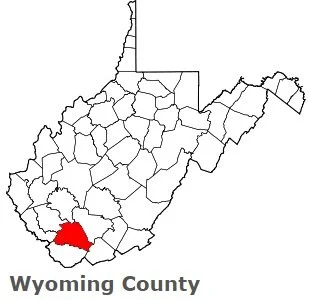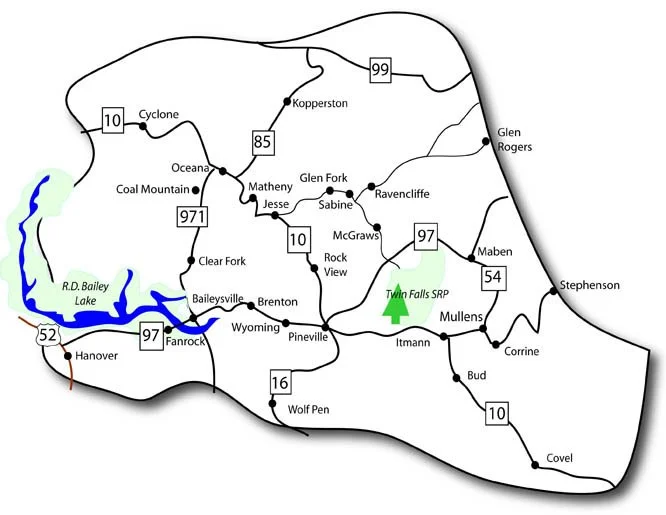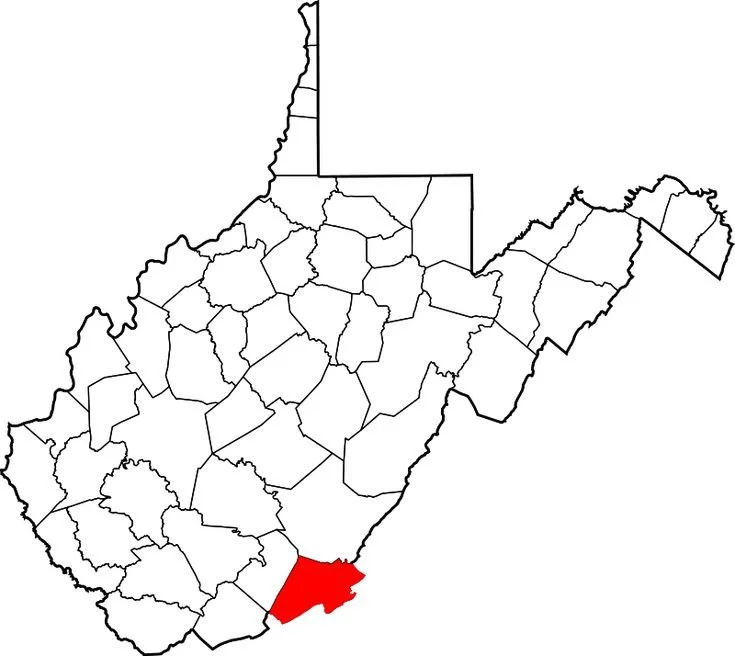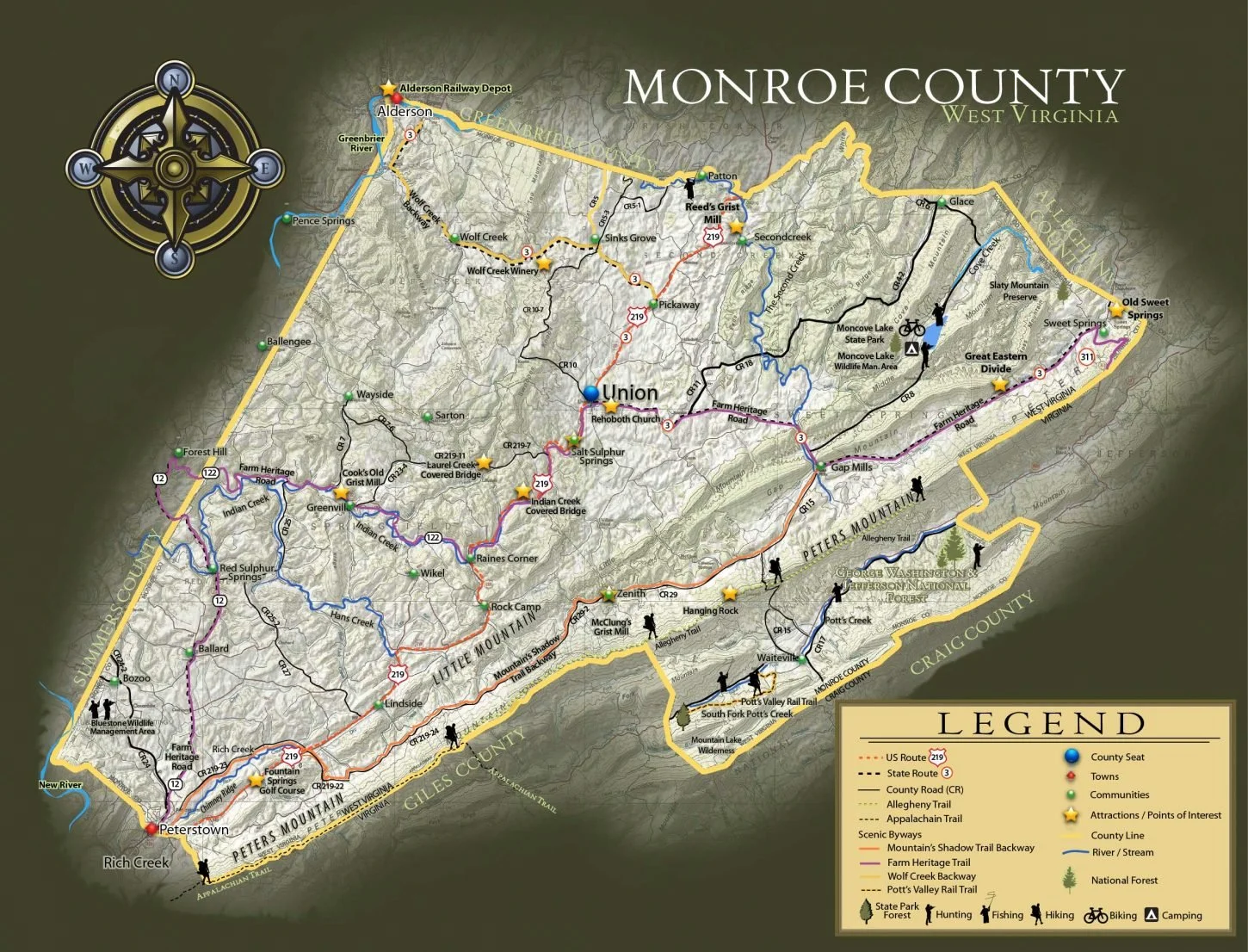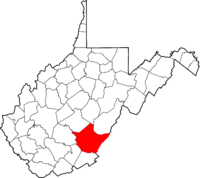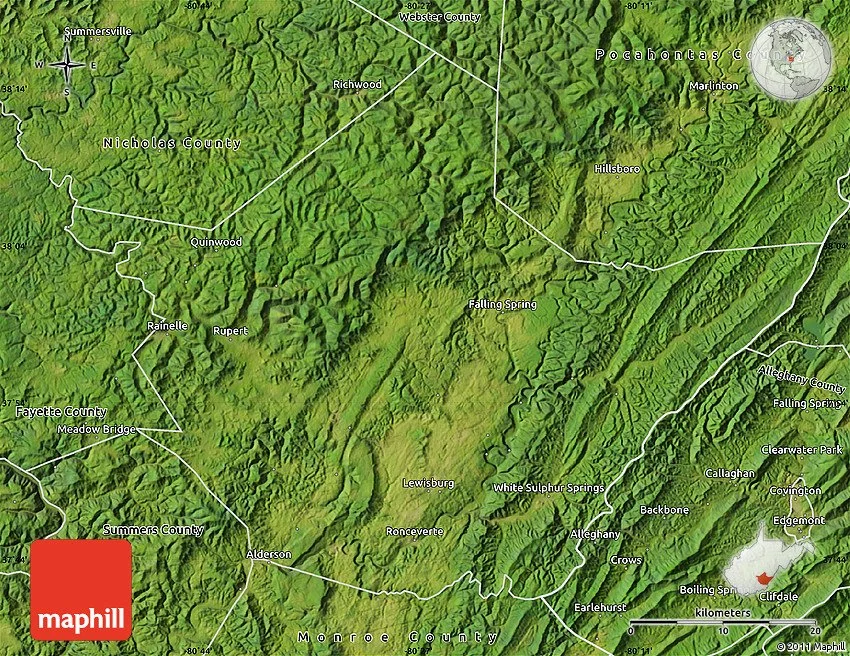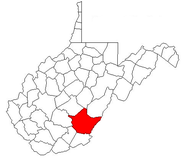Raymond Shanton Workman & Serilda Webb, 1818-1890
Family history in this section was compiled by Phil Hayes.The original content of his treatise entitled A WORKMAN FAMILY HISTOROY: from Jans William to Melvrie is presented herein without alteration.
Birth:
In the later part of 1818, Raymond Shanton Workman, my paternal 3rd great-grandfather, was born the oldest of possibly eight children of Joseph Workman, Jr., and Elizabeth Reed. At that time, Joe and Elizabeth may have already been living in their new home at Joe Branch along the Guyandotte River (or high above on Micajah Ridge) a few miles down-river from present day Itmann, Wyoming County, WV.
Elizabeth’s mother was Mary Shanton; therefore, Granddad was probably named after his maternal grandparents.
According to Sayre, Granddad was born in Giles, or Monroe, County, (W)VA. I am inclined to believe that he may have been born in Monroe County because Elizabeth and her parents are thought by some to have lived around Gap Mills which is in present day Monroe County. Monroe was formed in 1799, so that area would not have changed county names as did the area around Mullens. In any case, it is very believable that Elizabeth went home to Monroe County to give birth to her first child.
In 1818, Joe Branch was probably in Cabell County, VA. It was in Logan County after 1824, and then in Wyoming County after 1850. After 1863, it was, of course, in West Virginia.
Shanton may have had five brothers: Charles William (b. c 1819), James Madison (Mattison?) (b. c 1823 / d. 1896), William Washington (b. 1830), and George W. and George Floyd, possibly twins (b. c 1835). He may have had two sisters: Mary Ann (“Polly”?) (b. c 183d), and Malinda Jane (b. ?).
Wyoming County, WV (present day)
Monroe County, WV (present day)
Childhood:
The family lived at Joe Branch until around 1828 when Shanton was ten.
The family then moved across the river to a new home on Workman Branch of Still Run where Joe lived until his death in 1853.
Shanton would have turned twenty-one around 1839; although, it’s not clear that he remained at home until then.
Education:
Details are unknown.
Military:
Sayre says that Shanton’s son Fielding believed that his father served in the Civil War; however, no record has been found. Sayre said he could find no record and I have been unable to find any record to date. We should note here, however, that Shanton was around 43 years old in 1861 when the Civil War started. If he served for the Union, he could have been in the Home Guard—a sort of “National Guard” of the day which was manned by men too old for the regular army. I believe there are a few listings for the Home Guard in Lewis’ Soldiery of West Virginia, but Shanton was not listed.
If he served for the Confederacy, he could possibly have served for someone else. I believe they had a proxy policy similar to the British, whereby, one could pay for another to serve in his place. I don’t know how the records were kept in such cases. The muster rolls in the archives are kept by unit; so, if a soldier is not listed in the published indexes, the search through all units could be very time consuming—as in, practically impossible to find.
Occupation:
In 1850, the census listed Shanton as a farmer.
In the 1860 Wyoming County census, there is no occupation listed, although he is listed in the Slab Fork District.
In the 1870 Wyoming County census, neither he nor his immediate family is listed.
I believe it is very likely that Shanton hunted and trapped while he lived in Wyoming County –following family tradition in his father’s footsteps.
In 1873, Sayre says that Shanton farmed after moving to GreenbrierCounty.
In the 1880 census, he is listed in the Falling Spring District of GreenbrierCounty, WV, as a farmer.
According to Judy Workman Dunn, Granddad may have also worked in the timber industry after moving to Greenbrier County. However, he was around 55 years old 1873 when he moved there.
Greenbrier County, WV
First Marriage, Serilda Webb:
“Shantle Workman was married to Srilde Weeb on August 2, 1845 by David Payne in Tazewell County, VA., ” as recorded in Tazewell County Register #2. He was around 27. She was around 25.
Sayre says that they were probably “married” around 1840 “as the necessity arose.” Proper ceremonies, he says, were then held when a visiting minister became available. This may presume to answer the first question which arises below as to why the births of two children were before 1845. It doesn’t necessarily answer the question when one considers that they lived in the headwaters of the Guyandotte River which was in Logan County at that time; but, were married in Tazewell County which is beyond the head of the Bluestone River –some sixty, or more miles away –five years later. They, it would appear, were the ones “visiting.” Moreover, Serilda’s father was a minister. Why didn’t he many them?
Serilda was the daughter of George and Elizabeth (Keller) (Perdue) Webb who were also some of the first settlers in Still Run of the Slab Fork District. George was from Botetourt County, VA. Interestingly, he is thought to have been a captain in the Union Cavalry; although, I have not been able to find any record in the West Virginia Archives.
George was a preacher, but, he was also considered a “witch” by the community because he “cast a spell” over his Bearwallow Ridge hunting ground to “prevent other hunters from killing game” there. His methods were really a ruse to protect the Native American friends and relatives of his son-in-law who was Cherokee. The Indians were given sanctuary on his 600-acre from the US Army round-up which is known as the “Trail of Tears.” This anecdote was found in a letter to the Assistant Supertintendent of Twin Falls State Park from David G. Webb, Jr. There was also a story featured in the West Virginia Hillbilly newspaper about the legendary George Webb. The newspaper story included a picture of his cabin on Bearwallow Ridge. In March of 2004,1 visited the cabin where it still stands on the ridgetop near Station Gap which is the northern entrance to the Twin Falls State Park.
The oldest picture that I’ve found of a Workman ancestor is of Serilda. It was found on page 92 of Sayre’s book.
Married Life, Serilda:
Shanton and Serilda appear to have had twelve children, eight boys and four girls. The boys were George Washington (b. 1848), Fielding (b. c 1850), Benjamin (b. 1852), Shanton, or Shelton, (“Shent”?) R. (b. c 1855), Franklin (b. c 1856), William Henry (b. Aug 19,1859), Zacariah (b. c 1862) and Joseph L. (b. c 186d). The girls were Mary Ann (b. c 1841), Sarah (b. c 1844), Oily (b. c 1847), and Phoebe (b. Apr 20,1853). All were probably born on, or near, Still Branch.
Both Shanton and Serilda grew up on Still Run. According to Sayre, the Webbs lived two houses from the Joe Workman home as indicated in the 1840 Logan County census.
In 1850, the census lists them living in the Slab Fork District of Wyoming County, VA. (Wyoming Co. was formed in 1850.)
In 1853, the family was living in Slab Fork, Wyoming County, Va., when their daughter, Phoebe, was born, according to the Wyoming County Birth Records,
In 1859, the family was living in Slab Fork when their son William was born.
In 1860, they were still listed in the Slab Fork District of the Wyoming County census.
Sometime during the 1860’s, Shanton and Serilda are thought to have divorced. Sayre says that she filed for divorce around October of 1860 and moved to Pineville taking her children with her. However, he says they were still having children up until 1867. My research indicates that Joseph L. was born in 1864, although that is probably beside the point here which is that they were still having children after she filed for divorce.
Sayre says their divorce must have become final around 1869, or 1870.
In 1870, in my research, Serilda, one daughter, and seven sons were living in the Washington District of Braxton County, WV., where I found her listed under the household of Daniel Murphy in the census. This doesn’t necessarily conflict with the anecdotal account below because she could have stopped off in Braxton County along the way temporarily, or she may have just been picked up in the Braxton County census survey. Orlando is almost exactly on the county line.
I could not find a Washington District on the current map of Braxton County, so the district names must have since changed.
In 1871, Serilda moved to Lewis County, according to Sayre, who recounts two family anecdotes here that are interesting:
"...She (Serilda) never remarried, but brought some of her children by covered wagon to Lewis county to start a new life. They arrived at Confluence (now Orlando) about 1871. The older ones made the trip on foot for the most part, and the younger ones rode on the backs of oxen... (anecdote) given in part by Clennie Workman... as told to him by his father Fielding Workman (GD Shanton’s younger brother).”
"... By Fieldon Joseph Workman, gg grandson of Razilda,... Razilda was a midwife and regarded by many in the old days as a ‘country doctor.’ She traveled from Wyoming county to what is now Orlando in a horse-drawn wagon. Her sons drove cattle and other livestock as they went. The distance was about 170 miles and there were no paved roads. Many areas which they crossed were virtually unsettled tracts of wilderness.”
The current map of West Virginia shows Orlando on Oil Creek in the headwaters of the Little Kanawha River near Burnsville, just across the Lewis County line with Braxton County and in the Collins Settlement District
Grandma Serilda’s trip to Lewis County begs the question: Why? Why would she have undertook such a trip as recounted above? She didn’t remarry; so, it apparently wasn’t to go to, or with, another man. Although the Braxton County Marriage Record lists her oldest daughter Mary Ann being married to James J. Nottingham on the 21st of March 1871, that certainly doesn’t seem cause enough to move herself and her remaining children through the wilderness to Lewis County. The death of her father George Webb was in February 1872 –after she was already in Lewis County. This is a mystery worthy of further research.
Another, and possibly related, mystery is why were there so many deaths on Still Run in the winter of 1871/72 as recounted in an anecdote that Sayre quoted in his book from the WPA book, Pineville,about the death of Serilda’s father George. The anecdote tells how John Workman, in February 1872, was building a kitchen on the Bower cabin (in the head of Still Run –and, now within the Twin Falls State Park) and “... to his great irritation, neighbors borrowed his boards for coffin wood as fast as he sawed them...”
Where was Granddad Shanton at that time? Did Granddads Shanton possible service and George’s service during the Civil War have any bearing on events?
Many accounts of the Civil War in West Virginia mention bush whackers and other types of home militias who roamed the countryside during the war. Devil Anse Hatfield’s Wildcats were one such group. One of the Hatfield and McCoy Feud books found at Tamarack discusses the role that Civil War animosities played in their feud. Devil Anse was Confederate and Randall McCoy was Union in sympathy. Questions. Questions?
In any case, the l880 census has Razilda (Serilda) listed as a widow living in the Collins Settlement District of Lewis County, WV., with five of her children and a daughter-in-law, Ardmissia, who was married to her son William.
The 1890 census was destroyed in a fire, so there is no information for that period.
On 17 January, 1899, GM Serilda (Razilda) passed away and was buried in the Skinner Cemetery at Orlando, Lewis County, WV. Her death was reported in the Weston World on February 1,1899, according to Sayre’s research.
In 1870, 1 did not find Shanton in any census record. We can only assume that he was still in the Wyoming County area. Then again, he may not have been.
In 1873, he remarried, and it is assumed that is when he moved to Greenbrier County.
All of the family’s names are something of a jumble with all sorts of spellings; however, there is reasonable similarity in the spelling and in the given ages over time in the records. Shanton is also listed as Shantle. Serilda is found as Srilde, Sarilda, Surilda, Civil and Razilda. The children suffer the same problem with Oley also listed as Polly, George W. as Washington, Fielding as Fielden, Phoebe as Phebe, Shanton R, as Shent and Shelton, Franklin as Frank, and Joseph as Josiah.
Braxton County, WV
Lewis County, WV
Married Life, Dulcena:
Shanton and Dulcena, or “Lucina,” had nine children, two boys and seven girls. The boys were: Henry Edward (b. c 1881?), and James (b. c 1886?). The girls were: Delilah (b. c 1874?), Margaret Jane (b. c 1876?), Rebecca C. (b. c 1878?), Merian (b. 1880? –died young), Marinda (b. c 1882?), Ollie (b. c 1884?), and Anneda (b. November 1887). Birth dates were estimated by dividing the time from marriage until Armeda’s birth. Thosevwere the only given dates. (Estimating the first birth at one year after marriage is more than a little dicey; however, 1 gave them the benefit of the doubt since the spacing was reasonable.)
From 1873 until 1890, Shanton and Dulcena apparently lived on a farm (possibly on Chestnut Ridge) near Cordova on Spring Creek in the Falling Spring District of Greenbrier County, West Virginia, throughout their married life.
Granddad Shanton passed away in 1890.
Dulcena married again in 1902 and lived to be around 106 years of age.
Spring Creek empties into the Greenbrier River at the village of Spring Creek which is located a mile or so east of US Rt. 219 north of Lewisburg, WV.
Cordova is located a few miles northwest of Renick on County Rt. 5.
Second Marriage, Dulcena Roberts:
On July 28, 1873, Shanton married Dulcena Roberts in Wyoming County, WV, according to Sayre’s research. He was around 55. She was around 30.
Dulcena’s parents were James and Rebecca Mullens Roberts who were both from Kentucky. She was born around 1843. Dulcena was first married to Mike T. Ford in Wyoming County, WV. This information was found under person number 141 in a book, First Families of McDowell County (West) Virginia, compiled by Norma P. Evans.
Religion, Health:
Unknown.
Death:
On September 7, 1890, Raymond Shanton passed away near Cordova in Greenbrier County, WV.
He is probably buried near Cordova in the Workman-Baldwin Cemetery; however, the grave, if there, is marked only by a field stone.
The Workman-Baldwin Cemetery is located at the 3000-foot level atop the southern end of Big Ridge that extends from Bee Knob down to the confluence of main Spring Creek and Beverly Fork. The main creek above Beverly Fork is known locally as “Long Hollow.” A map with driving instructions is available in the February 1963 issue of the Greenbrier County Historical Society publication Greenbrier County Cemeteries.
The cemetery is not shown on the 1995 Trout Quadrangle map. Access is across private property via three very steep and narrow dirt tracks which pull off to the right of county route 5/7 in the second cove upstream on main Spring Creek from Cordova. The road is not maintained by the state.
The approximate UTM Zone 17 coordinates are 4,213,500 meters north and 50,000 meters east.
Cordova, Greenbrier County, WV (present day)


